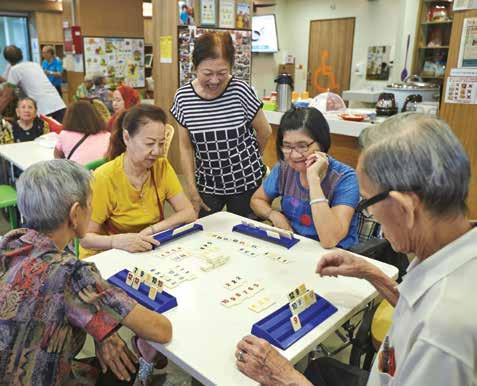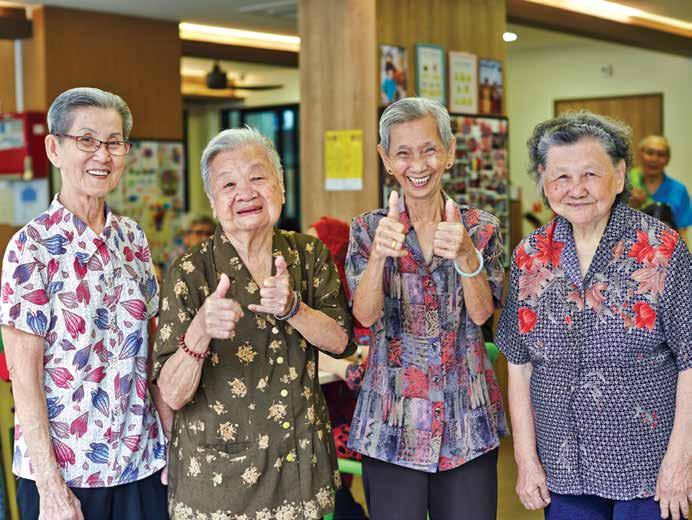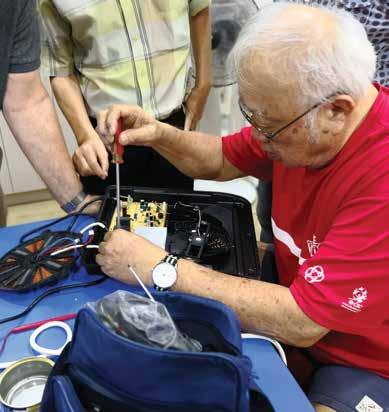
9 minute read
ACTIVATING THE 'COMMUNITY' IN COMMUNITY CARE
Yishun Health believes in engaging people before they fall ill, empowering them to be pro-active about their own well-being, and encouraging them to consider treatment away from acute care settings.
As a geriatrician, Dr Wong Sweet Fun specialises in the care of older people and diseases that affect them. Around the early 2000s, she noticed a worrying trend. Not only was she seeing many older people in poor health and with advanced chronic diseases, she observed that their adult children were also suffering from issues such as diabetes and high cholesterol — albeit in much earlier stages.
Advertisement
This sparked her interest in preventive care and an almost two-decade-long passion for working in the community health arena. “I wanted to go upstream to ‘catch’ people before they fall ill,” she explains.
DR WONG SWEET FUN, DEPUTY CMB (POPULATION HEALTH), KTPH AND YISHUN HEALTH
At the time, it was an unconventional route for a hospital-based clinician because preventive care and healthcare for the community outside the hospital were not seen as ‘medical’ care. However, Dr Wong was undeterred. Community health is also part of the healthcare spectrum — even more so in light of the preventable lifestyle diseases and escalating healthcare costs, she says. “The community health approach broadens the mission of healthcare from just a medical goal of curing illnesses — which is not always possible — to empowering people and using existing resources to help people manage their conditions in the best way possible,” she emphasises.
Dr Wong started some of the first interactive health promotion programmes in Singapore, the Health for Older Persons (HOP) and Home for Independent Persons (HIP) programmes in 2001. Over the years, such community health programmes have not only evolved, but are now a prominent feature across healthcare institutions and nonhealthcare agencies.
Today, Dr Wong wears many hats at KTPH and Yishun Health — Chief Transformation Officer, Deputy Chairman of the Medical Board (Population Health), and Clinical Director, Population Health and Community Transformation (PHCT) — and she continues to spearhead many health and wellness initiatives in the community.
BEYOND HEALTH SCREENING Yishun Health’s community health screening do more than test blood pressure, cholesterol and blood sugar levels. It is an important platform to educate and empower residents to take responsibility for their health and manage their conditions well to prevent and delay complications. Screening the community helps Yishun Health understand the health profile and needs of the population under its care. This ground knowledge goes towards developing better and more relevant initiatives to anticipate and meet community needs.
MAXIMISING RESOURCES IN THE COMMUNITY
In contrast to hospital-based care, Dr Wong highlighted that improving community health is not about deferring to the expertise of doctors, nurses or other healthcare professionals. Rather, it is about complementing this and empowering patients, their families, caregivers and even neighbours to play a role in care.
“We are activating the help that is already available,” she points out. “People have their own support system, and the community has its own resources.” The role of healthcare institutions is thus to facilitate, empower, educate and bridge the gaps between all the various stakeholders. At Yishun Health, various efforts have arisen to do just that. These shift the language of care from telling to showing, interacting rather than instructing, and educating patients and residents to support themselves.
While this takes time and effort to develop, this shift in the care model is taking root, says Dr Ang Yan Hoon, Senior Consultant, Geriatric Medicine, KTPH. She leads Yishun Health’s hospital-to-home initiative known as the Ageing-in-Place Community Care Team (AIP-CCT). Under this programme, a transdisciplinary team of doctors, nurses, therapists and medical social workers conducts home visits for patients who have recently been discharged from hospital.
“The goal is to settle them back down at home, and make sure that their medical, nursing and functional issues are taken care of,” she explains. This is done by equipping family members and caregivers with the knowledge and skill to deal with the various aspects of care. “This education and awareness is a slow process, but we are seeing more patients taking charge of their own health.”

At the Wellness Kampungs, simple games such as Rummy-O help senior residents stay socially and mentally active on their own
It is a team effort, she insists. “It is not just about getting help from the medical teams, but self-management and having family members become more involved in care.”
COMMUNITY NURSING: A ‘SMART’-ER WAY
Adding to the community health model is a new breed of nurses.
While the traditional approach to medical diagnosis trains doctors and nurses to ask ‘what’s the matter’ with patients, it is just as important to ask ‘what matters’ to a person. It is this mindset that guides the work of community nurses such as Bevin Tang, a Staff Nurse who is part of Yishun Health’s Self-Managed Autonomous Regional Team (SMART).
SMART gives community nurses more autonomy to manage their work. Bevin can design customised care plans and make joint decisions with clients on their own care. “When I understand a person’s priorities, I may then review care plans and medications accordingly so as to help my clients adhere to medication regimes better,” she says. This could even lead to reducing medications and/or medical appointments with the doctor in charge.
The goal of SMART is part of an overall community nursing effort to de-medicalise healthcare, says Ng Huoy Ling, Nurse Manager, SMART. “We also look at social, functional, emotional and psychological wellness,” she shares. “This is because more medicine or more trips to the hospital are not always the answer.”
This approach puts ownership back into the hands of people, adds Laura Tham, Nurse Clinician, AIPCCT, who works alongside Huoy Ling. “With community nursing, we are going back to basics and teaching people how to take care of themselves.” This may mean getting them to take blood pressure or blood sugar readings and helping them to make sense of the results. If there is an abnormality, they may be asked to think about the cause — could it be that they missed a dose of medication or have been eating more than they should have? These interactions help patients become more aware of their own conditions and, more importantly, how to resolve the issue or where to seek help.
EXTENDING EYE CARE
Since February 2017, Yishun Health has run a community-based initiative to improve access to eye screening and medical care.
Called Community & Home Eye Screening Services (CHESS), the initiative is a collaboration between KTPH’s Department of Ophthalmology & Visual Sciences (OVS) and the PHCT. It targets residents aged 50 years and older as well as persons with diabetes of any age who have not had follow-up appointments with an eye doctor for more than a year.
According to A/Prof Yip Chee Chew, Medical Director, Admiralty Medical Centre, and Head and Senior Consultant, OVS, KTPH, CHESS makes access to eye screenings more convenient without the need for specialist resources. Under the programme, community nurses and healthcare assistants do First-level Community Eye Screening (FiLCES). If any problems are picked up, the person will proceed to have a Second-level Eye Consultation (SeLEC) by optometrists at the Wellness Kampungs. These consultations are done under the tele-supervision of a KTPH ophthalmologist.

Yang Lijun (Optometrist, OVS, KTPH) giving one of the residents an eye screening at the Wellness Kampung
“The model revolutionises community eye care by empowering nurses and optometrists as physician extenders,” says A/Prof Yip. “This allows us to leverage the skills of nurses and optometrists, who are able to spot problems and refer patients to the right type of care.” Depending on their condition, they may be referred to an optician, GP, polyclinic or specialist. This scalable model means that care can be more appropriate, and has reduced referrals to specialists. More importantly, adds A/Prof Yip, it has increased healthcare accessibility for the seniors and home-bound, and lowered the cost of screening and managing eye conditions. These innovative efforts were recognised at the 2018 Public Sector Transformation Awards.
DR WONG SWEET FUN, DEPUTY CMB (POPULATION HEALTH), KTPH AND YISHUN HEALTH
PULLING TOGETHER FOR HEALTH
Other Yishun Health efforts focus on simply bringing people out of their homes and into their neighbourhoods. “The community needs to become a ‘pull’ factor that draws residents out of isolation into wellness,” says Dr Wong Sweet Fun. The Wellness Kampungs, for example, have become hives of activity for many in the community. They congregate for group exercises, art classes and games — and even volunteer for programmes such as Share a Pot ® and Repair Kaki. Share a Pot is a weekly soup and exercise programme (read more on page 14), while Repair Kaki brings together handy residents with DIY skills to fix household appliances.

Four of our Wellness Kampung regulars smiling after a hearty bowl of soup!
“These social activities do more than generate good times, but good health too,” says Dr Wong. “By building better social networks and raising the level of participation in social activities, we can lower the risks associated with cognitive decline and raise levels of psychosocial and physical health.” Social connections can also be used to reinforce positive health messages indirectly. Dr Wong calls this ‘stealth health’. She shares, “Traditionally, smoking cessation counselling has not been as effective as we would have liked. However, we encountered an ‘epidemic’ of quitting among our Repair Kaki uncles.” It turned out that one of them had a heart attack scare and required surgery. This led to several of the other senior gentlemen smokers to quit.
DR ANG YAN HOON, SENIOR CONSULTANT, GERIATRIC MEDICINE, KTPH
A BETTER WAY FORWARD
For Dr Ang Yan Hoon, these new approaches in healthcare delivery are an important evolution to keep care cost-efficient and sustainable. Hospital-based acute care is not always the answer to managing chronic illness. “Hospitalisation in an acute-setting is expensive to the patient as well as the system,” she points out. “There is also an opportunity cost for family members.”
By empowering patients, family members and caregivers to tackle simple medical issues at home, it saves them time and money, and reduces the burden on the hospital system. It also greatly improves the quality of life for patients. “Home care is more convenient for the patient as they have more autonomy and freedom,” she assures. “There is also less risk of acquiring hospital infections.”
So while the hospital continues to invest resources and enhance processes to integrate care in the acute setting, just as much effort is being invested in building community care initiatives. Managing health and medical issues in the community is the way forward, says Dr Ang, especially in light of an ageing population and increasing prevalence of chronic illnesses.


“The goal is to build a selfmanaged community, and to cut down on hospital utilisation, including admissions and emergency department attendances,” Dr Wong notes. “To do this, we will continue efforts to support patients in the community and empower them to manage their own health.”

